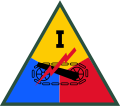Colored shoulder-sleeve insignia
Early SSI were designed with bright colors and detailed symbols primarily for display on service or dress uniforms. During World War I, units such as the 81st Infantry Division began wearing colored SSI in combat zones, reflecting both practical identification needs and unit heritage. [5] While the patches were initially primarily for identification, they quickly became a symbol of pride and unit affiliation. [6]
In 1918, the 81st Infantry Division deployed to France after training at Camp Jackson, South Carolina. Its soldiers wore an olive drab felt patch featuring the silhouette of a wildcat named after Wildcat Creek, [7] which ran through the training post. This patch, worn on the left shoulder, became the first officially recognized SSI in the U.S. Army. [8] When challenged by other units, General John J. Pershing ruled in favor of the 81st's right to wear the patch and encouraged other divisions to develop their own insignia. The patch was officially adopted by the Army on October 19, 1918, establishing the precedent for shoulder sleeve insignia across the force.
Historically, full-color SSI were worn:
- On the 81st Infantry Division's uniform during World War I.
- On the brown service coat during World War II.
- On the green "Class A" uniform from the 1950s through the early 2000s.
- On the OG-107 utility uniforms during the late 1950s and 1960s.
They were also displayed on Military Police (MP) brassards, black or dark blue armbands with white "MP" lettering worn in garrison environments with both Class A and subdued field uniforms such as the Battle Dress Uniform or Desert Combat Uniform.
During this time, nearly all U.S. Army groups, field armies, corps, and divisions, as well as many major commands, had distinctive SSIs. These designs often contained symbolism relevant to the unit's origins, like the 82nd Airborne Division's "AA" for "All-American", and the 29th Infantry Division's blue-and-gray circle symbolizing its makeup of Union and Confederate states. Most units had unique patches, though armored divisions, the I Armored Corps, and the U.S. Army Armor Center used a shared triangular design with unit-specific numbers and, later, labels added to the patch.
With the transition to the Army Combat Uniform in the mid-2000s, and the eventual retirement of the Army Green Class A Uniform in 2015, full-color SSI were phased out. In their place, the Combat Service Identification Badge was introduced. It is a metal pin worn on the Army Service Uniform.
In recent years, the Army Green Service Uniform, commonly called the "pinks and greens", was reintroduced to reflect the WWII-era aesthetic. This uniform authorizes the return of full-color SSI on the left sleeve (ref: ALARACT 029/2021). [9] Soldiers currently wear subdued SSI on combat uniforms when in the field or deployed and full-color SSI on the AGSU and combat uniforms when specified by regulation. The CSIB remains in use on the blue ASU, but it is not worn on the AGSU or AGSU Class B shirt.
Subdued
Subdued Shoulder Sleeve Insignia were developed to ensure uniform concealment and soldier survivability in field and combat environments. These patches are produced in low-contrast, camouflage-matching colors and have evolved alongside the Army's field uniforms.
- Type III OG-107 Olive Drab subdued SSI (1966–1980s)
The OG-107 Olive Drab fatigues were in use during the Vietnam War. At the beginning of the conflict, soldiers went to war with full-color insignia, white name tapes and black and gold US Army tapes. But in 1966, the Army authorized subdued or green and black versions of the SSI patches to be worn instead. [10]
- BDU-era subdued SSI (1980s–2008)
The Battle Dress Uniform (BDU) was the standard field uniform from the early 1980s until it was fully phased out in 2008. To match the BDU's woodland camouflage, subdued SSI were created in olive drab, dark brown, and black. These patches were sewn onto the uniform. These versions are now obsolete, in accordance with the retirement of the BDU.
- DBCU / DCU-era subdued SSI (1990s–2008)
The Desert Battle Dress Uniform (DCBU) "chocolate-chips" and its successor the Desert Camouflage Uniform (DCU) were used primarily during Operations Desert Shield/Desert Storm, Operation Gothic Serpent, early Middle East tensions and the initial stages of Operation Enduring Freedom, and Iraqi Freedom, subdued SSI were manufactured in light tan and coyote brown [11] thread to match the desert color palette. Like their BDU counterparts, these patches were sewn on and have since been retired with the discontinuation of the DCU around 2008.
- UCP/ACU-erasubdued SSI (2005 —2019)
With the rollout of the Army Combat Uniform (ACU) and Universal Camouflage Pattern (UCP) in 2005, subdued SSI were reimagined with new color schemes: foliage green, gray, and black, occasionally incorporating maroon or red for units with distinctive branch colors (e.g., medical or artillery). These were the first Army-issued SSI designed with hook-and-loop backing, aligning with the ACU's modular configuration and shoulder loop fields. This allowed for easier removal, reassignment, and replacement, a significant shift from previously sewn-on insignia.
- OCP-era subdued SSI (2015–present)
The Operational Camouflage Pattern (OCP), derived from Crye Precision's MultiCam, replaced UCP in 2015 and is now the standard combat uniform. Current SSI are designed in bagby green, spice brown, and tan, with no foliage green. They retain hook-and-loop fasteners and are worn on the left sleeve to denote current unit assignment, and optionally on the right sleeve as SSI-MOHC to indicate combat service with that unit or previous units assigned to in a combat zone.


















